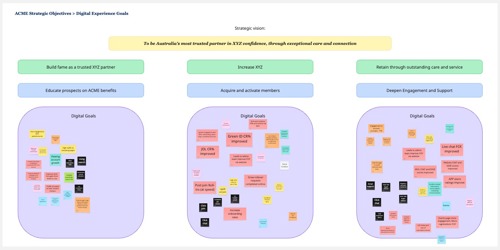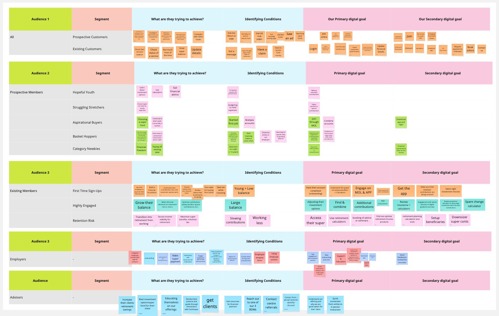From Tinkering to Transformation: Building a Culture of Digital Impact and Optimisation in the Enterprise

Across enterprise organisations, digital teams are sitting on incredible potential — powerful experimentation tools like Sitecore Personalize, analytics platforms, and marketing automation suites. Yet many are still only scratching the surface of what these platforms can do.
They run simple experiments: headline A/B tests, button colour changes, or layout tweaks. The results are often interesting but rarely transformational.
The problem isn’t the technology. It’s the lack of clarity and connection to deeper business outcomes.
When teams can’t connect experiments to real business drivers, the value stays locked behind disconnected tools, siloed ownership, and vague goals. They’re left with data, but not direction; dashboards, but not decisions. And importantly without the executive buy-in needed to really build momentum, invest and drive growth.
The shift begins when an organisation moves from running isolated and unconnected tests to building a system of continuous learning and visibility — one that connects capability, framework, and culture.

The Shift: From Tests to a System of Continuous Learning
The enterprises that make progress don’t just do more testing. They build an operating system for visibility and optimisation.
That system rests on three interlocking pillars:
-
Capability – the technical foundation to deliver and measure personalised experiences.
-
Framework – the structure that aligns goals, audiences, and ideas into a single optimisation program.
-
Culture – the collaboration and rhythm that turns experiments into learning and change.
Let’s break them down — with a focus on the framework, where transformation truly happens.
The Capability: Laying the Groundwork
Before you can scale experimentation, you need confidence in your foundation.
Ask yourself:
- Is your analytics data clean, understood, and usable?
- Is your experimentation platform (such as Sitecore Personalize) integrated and ready to deliver targeted experiences?
- Is your team trained and ready to drive your platform from a technical standpoint?
You don’t need perfection — just a functional baseline that allows you to measure, learn, and adapt.
Capability provides the runway.
The framework gives you direction.

The Framework: Turning Ambition into Action
This is where real change begins. A strong framework turns business ambition into actionable experiments that create measurable outcomes.
Step 1 – Define business objectives
Start with clarity on why optimisation matters. What are the business drivers that truly count — acquisition, retention, engagement, customer satisfaction? Every experiment should ladder up to one of these priorities.
Step 2 – Translate to digital goals
For each objective, define what digital success looks like. For example:
-
Retention → Reduce homepage exits for returning members.
-
Acquisition → Increase completion of the join flow.
-
Engagement → Lift use of calculators or educational tools.
These become the bridge between strategic ambition and measurable action.

Step 3 – Define audiences
Now it’s time to move beyond broad demographics to audiences that marketers can relate to and your technology can identify. Think:
-
Returning visitors who visited a specific category of page
-
Logged-in members who’ve not engaged with a specific tool
-
Prospective joiners arriving from paid campaigns
When your audience definitions make sense both to the marketing team and the data layer, personalisation becomes executable, not theoretical.

Step 4 – Ideate experiences
Now, bring cross-functional teams together to brainstorm the actual experiences you could create:
-
What friction or opportunity exists for each audience?
-
What experience could increase relevance or reduce effort?
-
Which digital property — homepage, dashboard, calculator, or email — is best suited to deliver it?
Capture every idea into a shared optimisation backlog.
Step 5 – Prioritise ruthlessly
Not all experiments are equal. Score each by value and volume. Start with high-impact, and high volume opportunities that give you a chance to build momentum and learn. Over time, evolve toward deeper, more complex, multi-channel experiences.
Step 6 – Execute and learn
For teams using enterprise tools like Sitecore Personalize, this is where you have maximum advantage. Instead of scattered experiments, organisations can run structured, governed tests across journeys — from behavioural triggers and decisioning rules to full-page or component-level variations — all linked to measurable business outcomes.
Run the experiments, track your outcomes, think deeply and document what you’ve learned and how it might apply to other channels, situations etc. The value isn’t just in the uplift — it’s in the behavioural insight gained. Feed every lesson back into your backlog and roadmap.
Over time, this framework becomes your repeatable playbook for ongoing optimisation.
The Culture: Making Optimisation a Team Sport
Technology enables personalisation — but culture sustains it.
The biggest unlock inside complex organisations isn’t another feature or API. It’s shared ownership. When marketing, digital, UX, and comms teams all work within the same framework, optimisation stops being someone’s project and becomes everyone’s job.
-
Marketing owns messaging hypotheses.
-
UX owns experience design.
-
Data teams own measurement fidelity.
-
Leadership owns the connection to business outcomes.
When collaboration becomes habitual, experimentation becomes part of the operating rhythm. Insights are no longer isolated in reports — they become the fuel for decision-making.
But shared ownership doesn’t mean leaderless. Every great optimisation culture needs a champion — someone who drives the momentum, connects the dots across teams, and keeps the purpose alive when priorities compete. And just as critical are senior advocates who don’t just approve the work but model it — leaders who ask for insights, participate in reviews, and make curiosity contagious.
When executives visibly value experimentation and progress over perfection, they signal that optimisation isn’t a side project — it’s how we learn, decide, and grow together.
The output isn’t more campaigns. It’s a living library and backlog of business improvement ideas.

The Payoff: A Continuous Learning Engine
The goal isn’t just to run more experiments — it’s to build a learning engine.
When done right, your optimisation program:
-
Aligns every digital initiative to a clear business objective.
-
Keeps teams focused on outcomes, not activity.
-
Turns Sitecore Personalize into a continuous learning loop, not just a delivery tool.
You move from reactive testing to proactive experience design — powered by clarity, data, and collaboration.
That’s what a culture of optimisation looks like.
Every enterprise can start this journey.
You don’t need dozens of experiments running to begin. Start by clarifying your business objectives, defining your audiences, and aligning your teams. The backlog, cadence, and culture will follow.
The technology may well already be in your stack. The opportunity lies in connecting it to purpose.
At Aceik, we help enterprise teams turn Sitecore Personalize into the foundation of a culture of continuous optimisation — where experiments don’t just test ideas, they drive transformation.
If you’d like to explore how to build your own optimisation capability and culture or unlock more value from Sitecore Personalize, get in touch with us today.
Let’s chat about how Aceik can help you stay ahead.